Unsure about your French table manners? Click Here to download > > How to avoid these 10 food etiquette mistakes !
- Home ›
- Destinations ›
- Southern France ›
- L'Isle sur la Sorgue
If You Love Antiques, Head For Isle sur la Sorgue In Provence
Published 9 August 2024 by Leyla Alyanak — Parisian by birth, Lyonnaise by adoption, historian by passion
If there’s one town in southern France I keep returning to, it’s Isle sur la Sorgue, right on the edge of the Luberon and filled with antiques and ambience. I recently revisited the “Venice of Provence” and it’s still the delightful market town I know and love.
If your idea of heaven is rummaging through stands overflowing with French antiques or bric-a-brac, you'll want to visit L'Isle-sur-la-Sorgue market on a Sunday.
Lining the edge of the River Sorgue in the town center, the men and women who make antiques their livelihoods arrive early, unpacking their vans and trucks even before the sun rises.
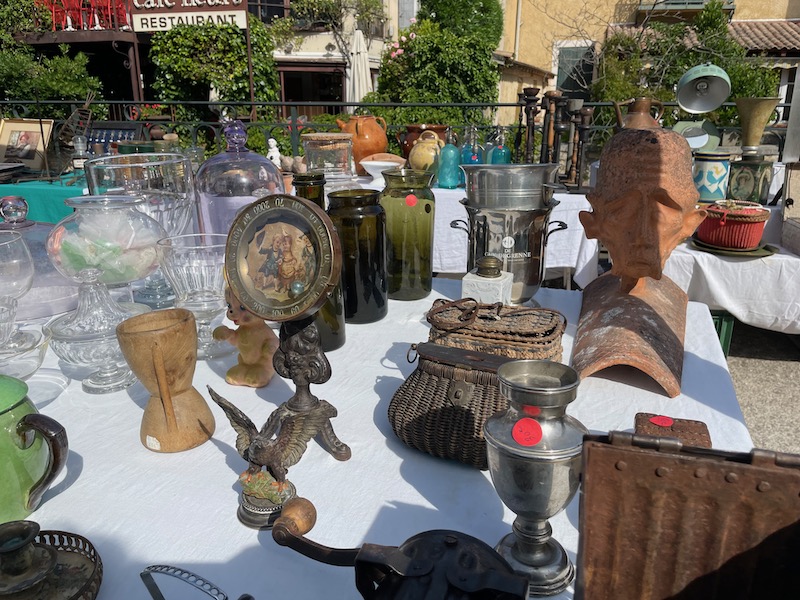
It will be a long day for them, well into the afternoon. It's also a gathering of sorts, because the same people work here each week. They know one another, smoke a cigarette together, or watch each others' stands when one has to take a break, a sort of camaraderie that comes from years of shared passion.
For us, the visitors or buyers or the merely curious, it's an adventure: we don't know what we'll find, but the excitement of the hunt for vintage is on.
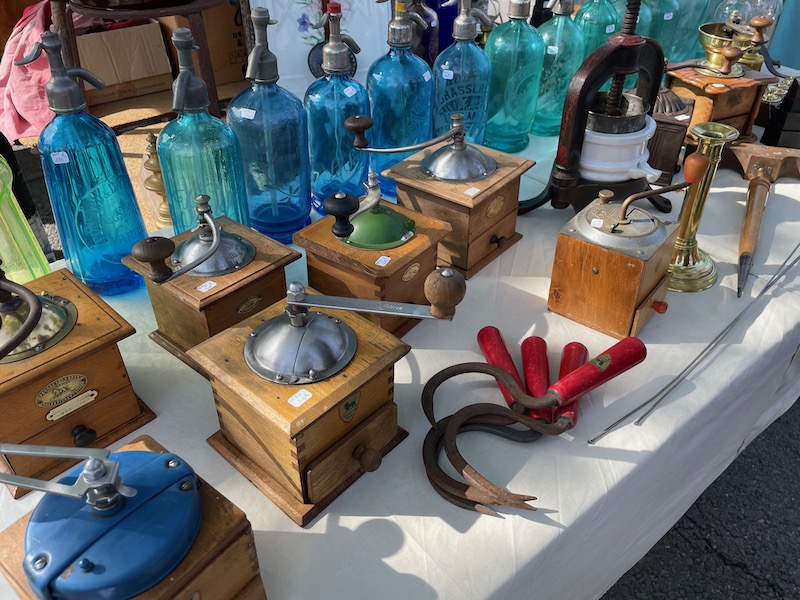
Rusted vintage cookie tins, straw chairs your great-grandmother may have sat on, an Art Deco mantle clock with bookends… even a chandelier, although your chances of finding the perfect Ancien Regime piece would be better in one of the “Antique villages” that dot the town.
France has many wonderful flea markets – this is a flea market town.
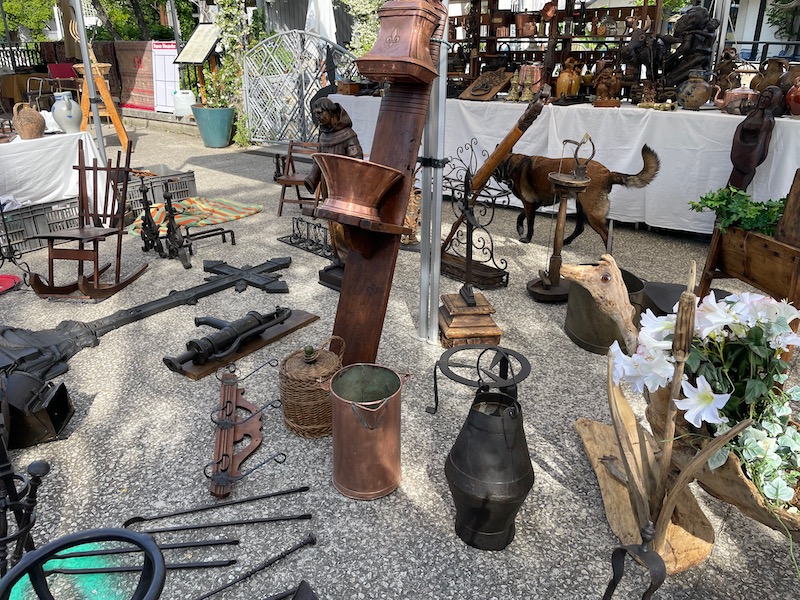
NOTE: Pages on this site may contain affiliate links, which support this site. See full Privacy Policy here.
The South of France is only a few hours’ drive from my home, so when I have an extra couple of days, it’s inevitable: my car has a will of its own and turns itself towards the Luberon – and there’s nothing I can do to stop it.
All I can choose is the “when”: I try to make sure I travel on a Saturday or early on a Sunday morning, in time to hit the weekly antique market at L’Isle-sur-la-Sorgue. That usually means leaving home around 5 a.m., but it’s absolutely worth it.
This is, after all, the antique capital of France.
A story of antiques
L'Isle-sur-la-Sorgue is one of Europe's leading hubs for antiques, and not just on Sundays.
On weekends, the town is crammed with antique shops, and twice a year, there’s a major antique fair here. The Sunday markets are just the tip of the iceberg.
There are good reasons why Isle sur la Sorgue has become such a magnet for the antique trade.
It’s location is ideal, near major trading cities like Avignon and Marseille, and the setting is stunning, attractive to visitors keen on antiques or not.
How can you resist a set of ancient working waterwheels along a meandering river, bordered by market stalls and cafés?
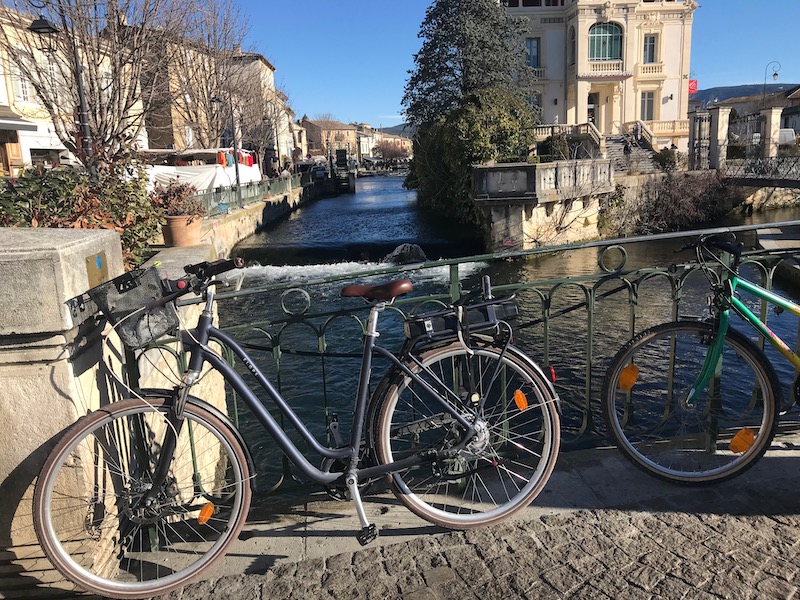
Tracing the town's love story with antiquing takes us back a few years to the 1960s.
It’s not clear how antique dealers first came here, but as soon as they did, word spread, and soon there were 300 antique shops serving an ever-hungrier public. Add to this a number of second-hand shops, antique markets and annual fairs and you’ve developed a major antique hub.
For additional atmosphere, you can always count on the cobblestoned streets, the many eclectic boutiques crammed with vintage items, and the energetic buzz of a Provençal market town.
HOW ON EARTH DO YOU SPELL AND PRONOUNCE THIS TOWN'S NAME?
It's a perfectly legitimate question to which I only have part of an answer.
First, the spelling. It can be anything! Technically, the town's name is L'Isle sur la Sorgue or L'Isle-sur-la-Sorgue, depending on which administration you approach. City hall and the tourist office spell it differently...
Second, the name itself changes − some will say only Isle-sur-Sorgue, leaving out a word or two.
And third, the pronunciation: leel-sewer-lah-SORGG. Have a listen:
The antique trade has left its mark on what was once a quiet fishing village.
Antiques have fueled other businesses, the tourism generated by the trade giving a boost to restaurants, hotels and art galleries. This, in turn, has encouraged historical preservation, especially of the town’s architecture.
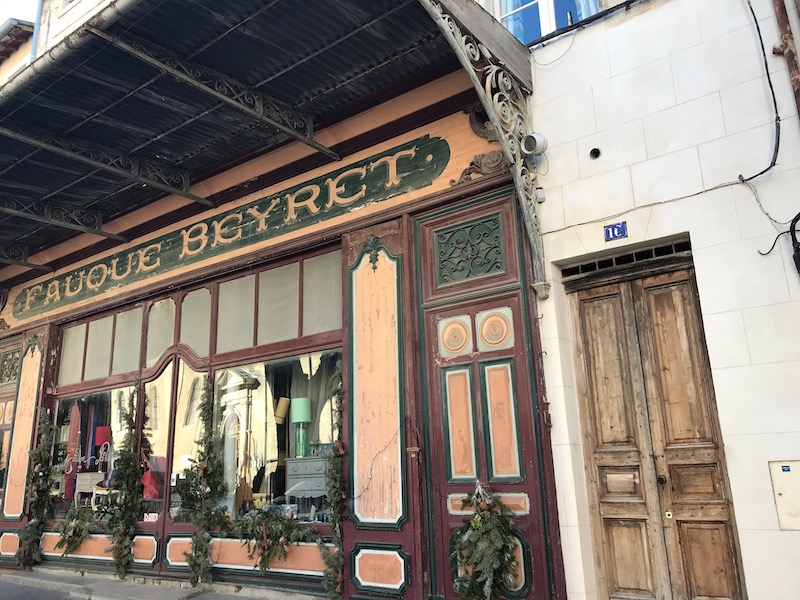 Signs of the Belle Epoque in Isle sur la Sorgue ©OffbeatFrance
Signs of the Belle Epoque in Isle sur la Sorgue ©OffbeatFranceAntique highlights of l’Isle-sur-la-Sorgue
You’ll have three distinct opportunities to shop here for antiques:
- On Sundays, an antique market − started in 1596 − with an irresistible atmosphere takes place alongside the weekly produce and clothing market, along the banks of the River Sorgue. This is more for bric-a-brack, although you can find some upmarket pieces if you show up early and know your French antiques. Still, this is for the everyday visitor who enjoys antiques and would love to pick up a few small pieces to take home.
- Throughout the weekend, six “antique villages” with some 300 shops are open all year round. You don’t have to be a professional to shop here, and the villages are welcoming, with many items spread outside (in the sunny weather of Provence). This is where you'll head if you’re looking for a few more serious pieces, or something that might require shipping.
- Twice a year, it’s time for the professionals to gather at the Foire Internationale Antiquités et Brocante. Once in spring, around Easter, and once on 15 August, hundreds of antique dealers from across Europe gather to offer everything from exquisite furniture to fine jewelry and rare books. What began in 1966 as a modest gathering of 14 exhibitors is now considered the third most important antique fair in Europe.
All of these venues have something for everyone. While collectors will find their fill, so will casual budget shoppers.
Imagine strolling around one of the villages and stumbling across a dusty box. You open it, and a treasure lies within: an antique engraved pocket watch, an early 19th-century piece signed by a famous watchmaker. According to local lore, this actually happened. It could have been any of us, and is an example of the lovely surprises that tempt collectors and the curious alike.
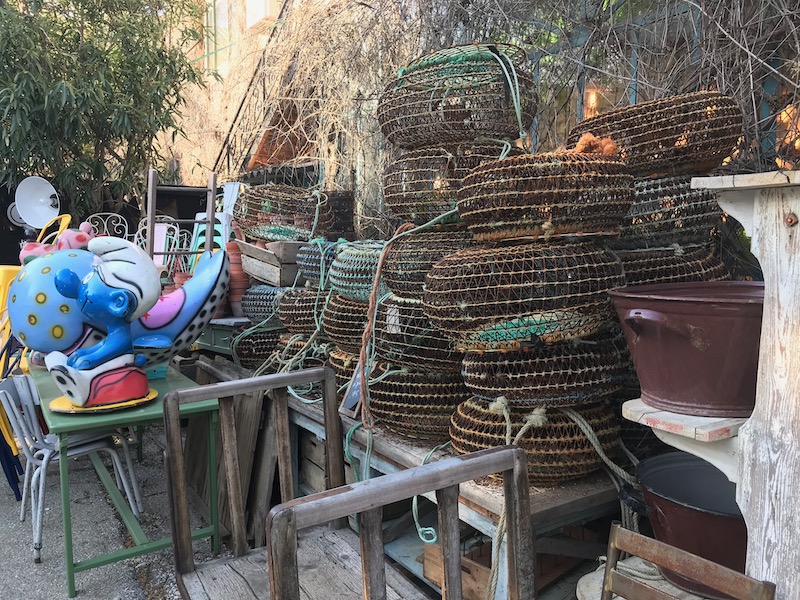 The antique villages can be quite eclectic, and you never know what you'll find ©OffbeatFrance
The antique villages can be quite eclectic, and you never know what you'll find ©OffbeatFranceTips for antiquing in l’Isle-sur-la-Sorgue
- Arrive early, whether it’s for a fair or the Sunday market. Everything gets crowded quickly and parking is at a premium. Not only that, but the best or most unique pieces go early.
- A bit of knowledge goes a long way, and will help you better understand what you’re buying.
- Set a clear budget. You’ll probably want to spend more than you planned, and if you’re not clear about your budget, the vast array of tempting items can easily lead to overspending.
- Don’t be shy about engaging with dealers; they’re often passionate about their wares and can provide fascinating insights into the history of specific piece.
- Don’t forget logistics: the bigger you buy, the more complex the shipping. Established dealers will handle arrangements, but it’s worth remembering the potential headaches.
THESE BOOKS MAY BE OF INTEREST
- French Furniture: From Louis XIII to Art Deco
- Vintage French Interiors: Inspiration from the Antique Shops and Flea Markets of France
- The Flea Markets of France
Beyond antiques: History of Isle sur la Sorgue
And now, it’s time to give in to my personal passion, a bit of history…
Not only are the objects on display reminders of the past, but the town itself is ancient.
Neolithic remnants have been found, and there are mentions of a castrum, or Roman fortress. Let us not forget the Via Domitia is nearby, a public road built in 118 BCE, which runs some 250km/155mi across Provence to the Pyrenees.
The town’s “modern” history begins around the 12th century.
Once a marshland flooded by the Sorgue, inhabitants lived off the river, in houses that stood on stilts. It wasn’t easy to master those marshes but eventually, the town became a thriving settlement famous for its textile and paper mills.
The fact that it was strategically located on the River Sorgue helped attract merchants and artisans, but the town really came into its own with the building of waterwheels to harness the water’s power. These water features powered mills for grain, paper, and silk production, establishing the town as a key industrial center in Provence.
Here its history diverged from France as the area fell under the rule of the Vatican’s Papal States, remaining under Rome’s control for some 500 years.
THE JEWS OF INSULA
There are a few early references to a Jewish presence in this area but the first concrete mention comes at the end of the 13th century, when Jews, persecuted elsewhere across Europe, found refuge here. L’Isle-sur-la-Sorgue, known back then as Insula, was part of the Comtat Venaissain, which became a Papal State in 1274. Papal States were enclaves located on the Italian peninsula, with the exception of Avignon and the Comtat Venaissin.
Jews lived here in relative freedom for the next two centuries, until the Papal authorities tightened restrictions and separated them from Christians, forcing them into a single street, or quarry, (“carreria” in Provençal) whose gates were closed at night.
Soon, Jews would be allowed to live in only four cities: Insula, Avignon, Carpentras and Cavaillon. These constraints would continue until the annexation of the Comtat Venaissin by France in 1791.
Religious affairs remained at the heart of the town’s concerns, and Protestantism was on the rise in the region − but not in the very Catholic town of L’Isle-sur-la-Sorgue, with its massive Franciscan convent. It became a bastion of counter-Reformation, with the creation of new orders and the building of a number of religious establishments.
Throughout the centuries, the area we know as Provence would be hit by plagues, with the largest in 1721. As disease spread north from Marseille, the Comtat reacted in a way that would sound familiar today: they built a wall to prevent the plague from spreading north from Marseille.
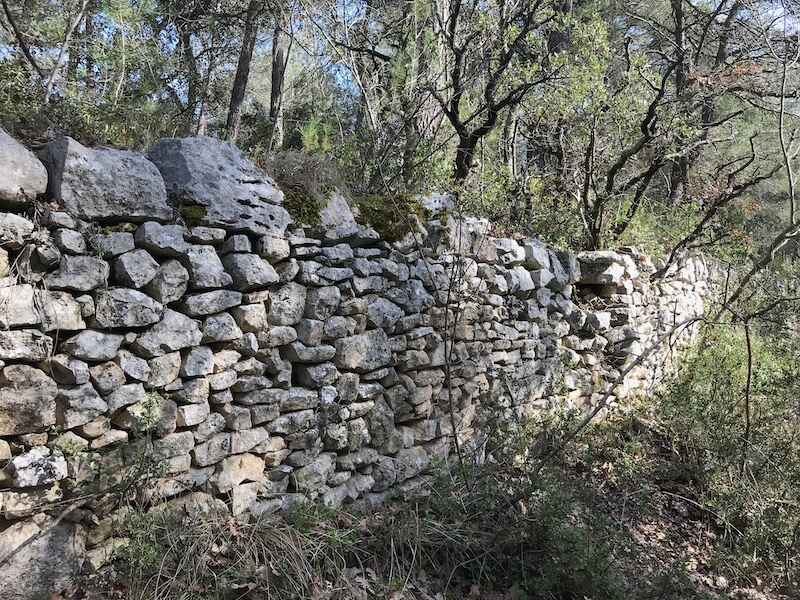 Remnants of the wall built by the Comtat Venaissin to keep out the plague from Marseille ©OffbeatFrance
Remnants of the wall built by the Comtat Venaissin to keep out the plague from Marseille ©OffbeatFranceThe Comtat would survive until the French Revolution, when its residents voted in favor of annexation to France.
The Revolution had hit the town hard, especially during the violent period known as The Terror. There was fighting, fires and pillaging. Part of the synagogue was destroyed and many religious buildings were sold. But, as elsewhere, the Revolution eventually ended (not without a few heads sacrificed to the guillotine) and the town entered a new, modern era.
By the 19th century, L’Isle-sur-la-Sorgue was known not only for its market but for its burgeoning textile industry, made possible by harnessing the town’s waters.
From its original name of “Insula”, it officially became L’Isle-sur-la-Sorgue in 1890.
As technological progress spread, industries began shutting down, and the only witnesses we have left of that time are the waterwheels which, impervious to time, continue their slow turns.
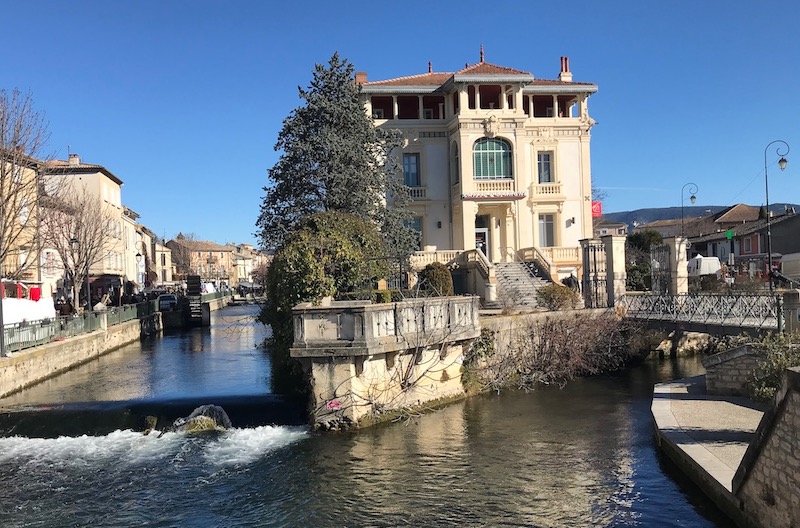
Today, the town’s main industries are tourism and antiques. It is part of the Vaucluse department (one of France’s 101 departments) in the region known as Provence-Alpes-Côte-d’Azur, or PACA for short (here’s a list of France’s regions today).
Things to do and see in L’Isle-sur-la-Sorgue
L’Isle sur la Sorgue is a charming little town of meandering waterways and whirring waterwheels.
It’s nickname, “Venice of Provence”, may be overstating it a bit, but it is known for its picturesque canals and waterwheels, an invitation to step back into the shade of a slower, calmer era.
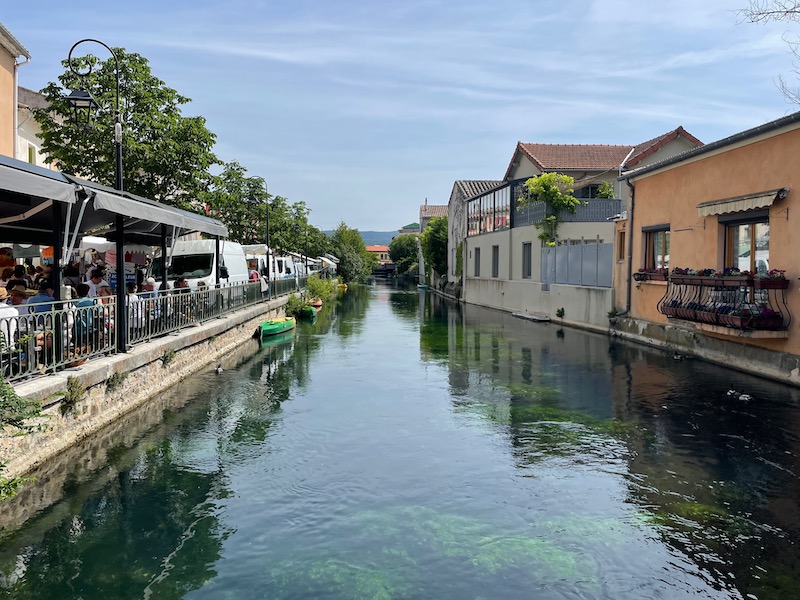
Even on Sundays, with its bustling market spilling into the streets, the town has a serene feeling − just walk a block away from the market and you’ll have the streets to yourself. It’s no wonder artists of all stripes have enjoyed coming here!
But to truly experience the town’s serene side, go a day or two early and get to know Isle sur la Sorgue before the market wakes up. Smell the scents of Provence, listen to the shopkeepers greeting one another as they raise their shutters, and sip your coffee at one of the local cafés as the world goes about its business.
The rest of the market
While the market is known for its antiques, it is also one of the two regular weekly markets, with plenty of other goods for sale, from local produce to artisan goods, so take a moment to buy a few tasty oranges, some lavender-scented candles, or some local cheese and a baguette for your picnic lunch.
I usually make a beeline for the scarves...
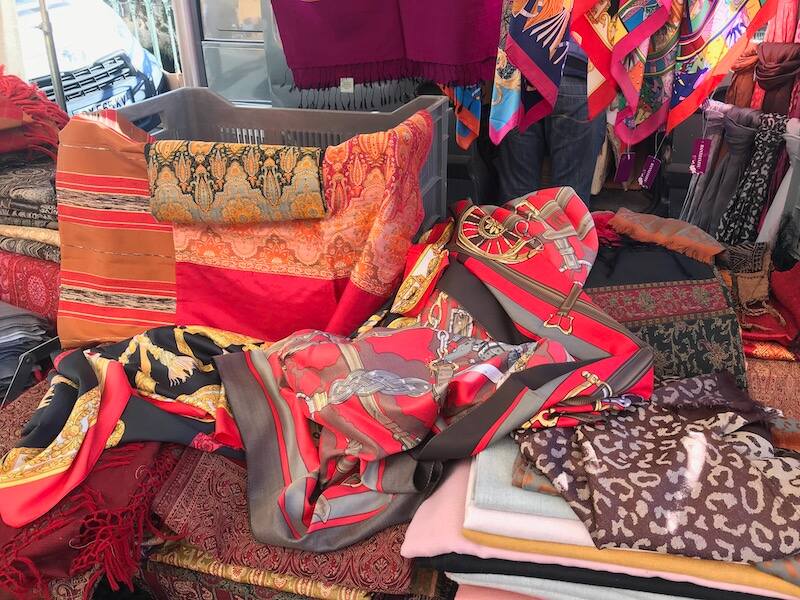
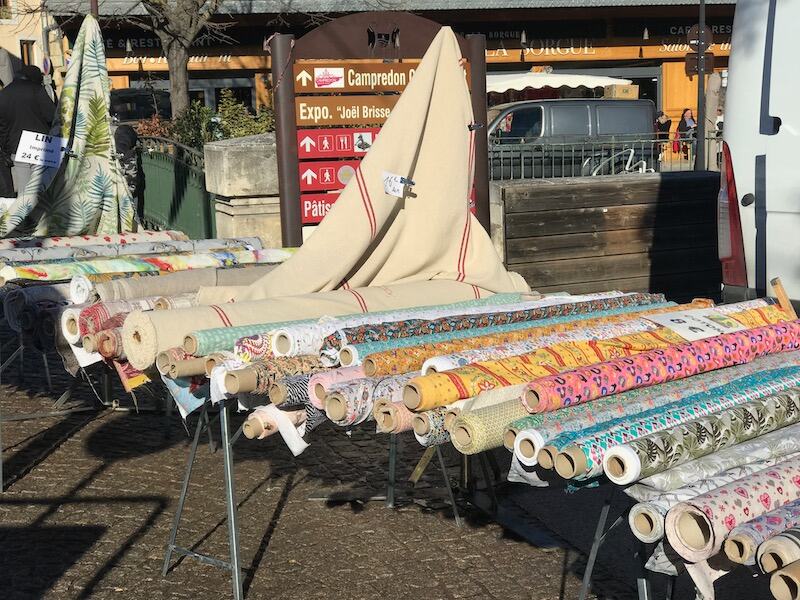
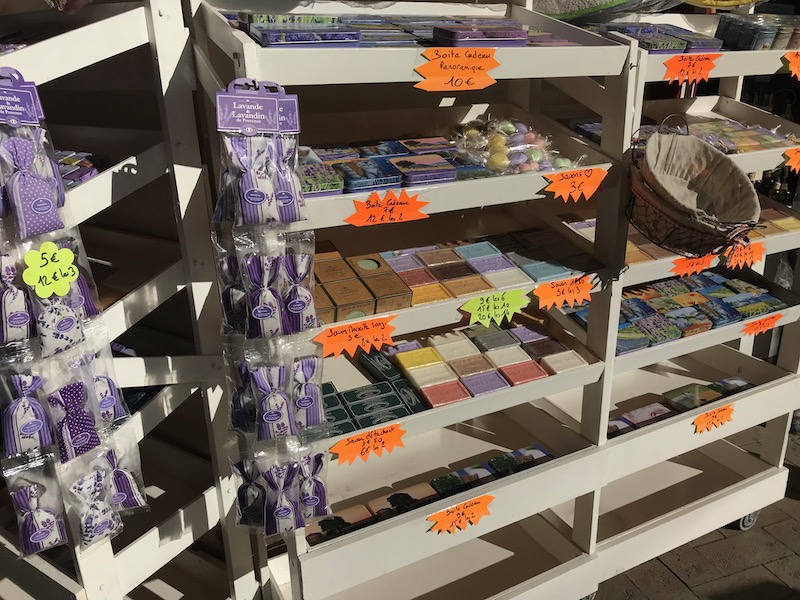
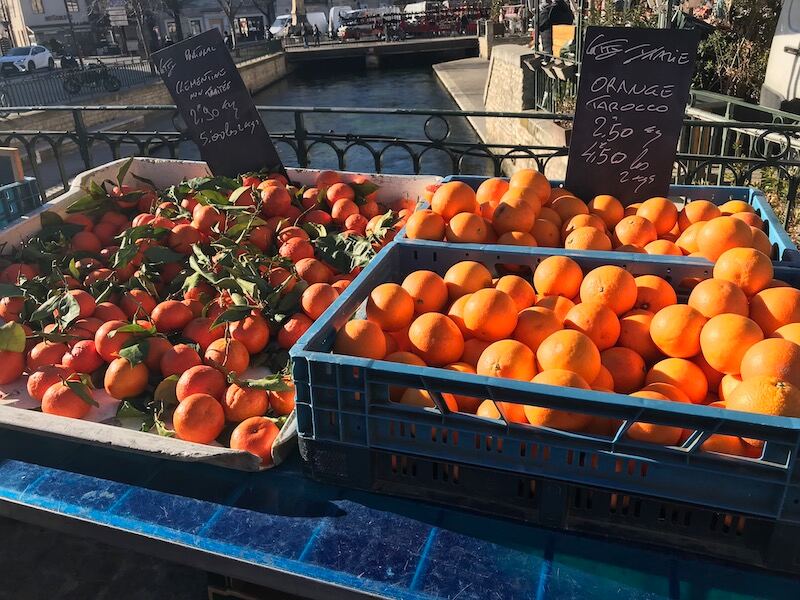
The old town
While the market is large and spills over onto many streets, there’s plenty of town left over beyond its stalls, so don’t hesitate to take a left here or a right there, which may lead you to a calm, eclectic café, a quiet canal, or some narrow Provençal streets trying to hide in the shade.
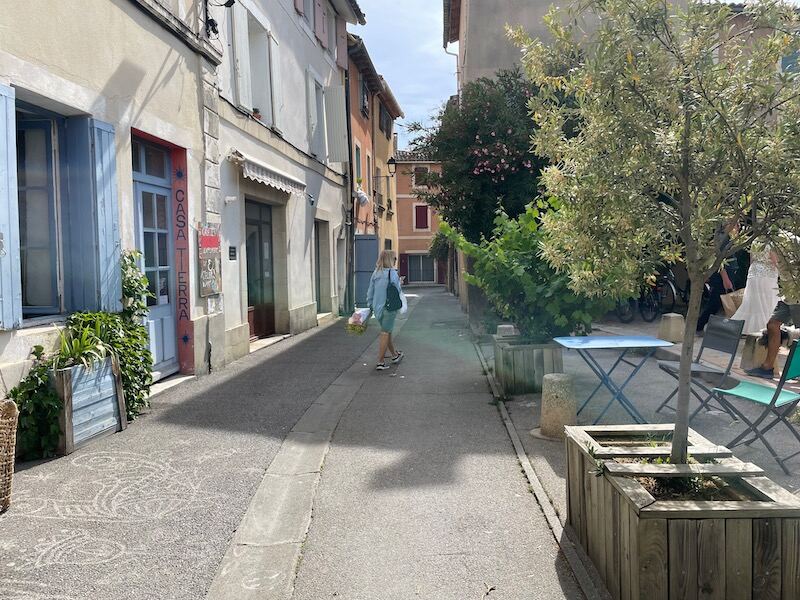
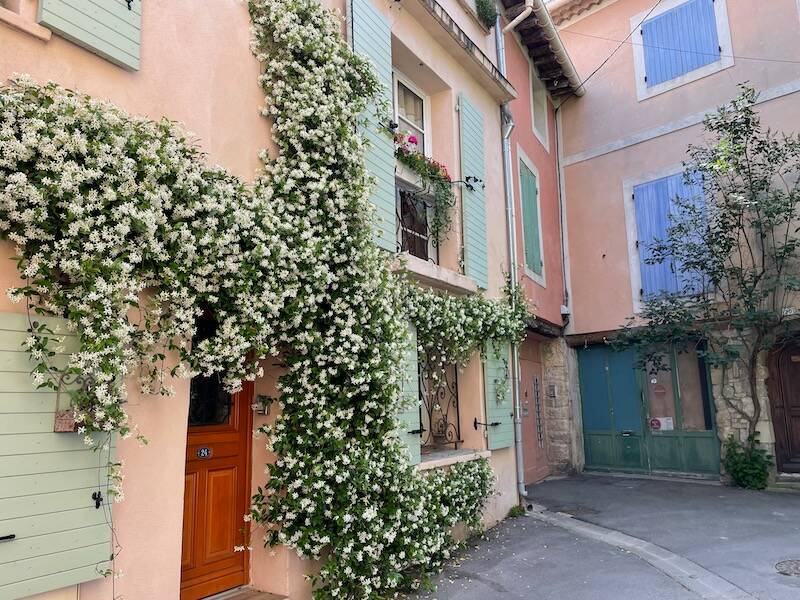
If you're in the mood, take a short walk out of town to look at the “partage des eaux”, where the river splits in two and the water and plane trees provide a bit of coolness...
Architecture and art
This is a handsome town, with pleasant architecture. Obviously the pièce de résistance is the 17th-century baroque Collegiate Church of Notre-Dame-des-Anges, with its ornate façade and intricate interior of gilded altars and vivid frescoes.
Sadly, I haven't been able to see it yet: it's closed when the market is on, and somehow I've managed to miss it at other times. On my next visit!
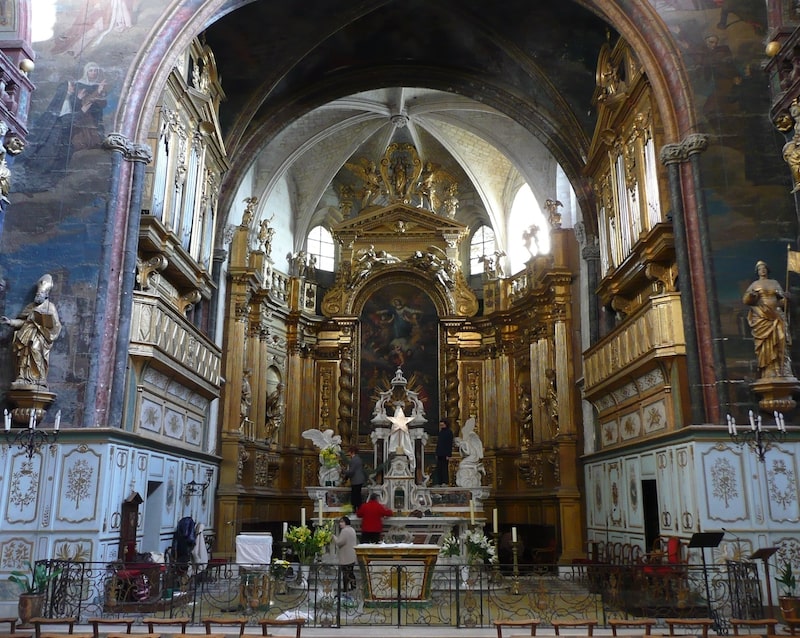
Getting to L’Isle-sur-la-Sorgue
Most people drive here, as I have done a number of times. After all, how else will you carry all those wonderful antiques home without a car? (The expensive ones can be shipped, of course).
On Sundays, parking can be a major challenge and the later you get here, the further away from the center you'll have to park. That said, I've always managed to find a space − it might just be a little more challenging. When possible, I arrive on the Saturday and stay over.
You can come by train but preferably from Marseille or Avignon. Coming from Paris might require one or more transfers.
From Avignon-Centre train station, the ride is less than half an hour. Get off at L’Isle-Fontaine de Vaucluse station, which is a 15min walk into the heart of the market.
From Marseille, the train can take anywhere from 1hr30min to nearly twice that. There are a few direct trains, but not many, and most will have you change to a train (or more likely, a bus) in Avignon. Check your train schedules carefully.
What to visit near L’Isle sur la Sorgue
- The Luberon villages, like these top 5, which are on the list of most beautiful villages in France
- Avignon and its Papal Palace (and site of one of France’s most beloved bridges)
- You are in Provence, so time to set out and explore!
Where to stay in L’Isle-sur-la-Sorgue
Spending Saturday night will give you a front-row seat for the antiques market on Sunday, and here are two excellent hotels, Domaine de la Petite Isle and the Grand Hôtel Henri − Teritoria, which both have parking.
Before you go…
Whenever I’m on a road trip through southern France and mention I’m visiting L’Isle-sur-la-Sorgue, I elicit a smile. Those in the know usually love it, while those who haven’t been want to go.
If you're ever in Provence, you have to visit at least once! Even if you don't like antiques...

